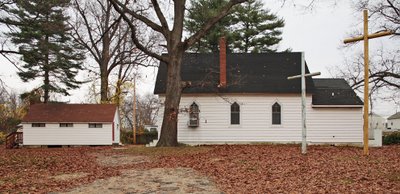When I was a kid we used to visit relatives in Rockville; it was a long, long, drive, and not just because we didn't like them, but because we had to travel through Columbia, Maryland. It was the dullest place in the world. There wasn't any variety there. It was just mile after mile of brand new tract-housing. No stores, no industry, no railroads, no farms, nothing decrepit, nothing historical, not even any people - just houses.
 It's my fear that Route 40 (East) will look that way soon: nothing old & nothing interesting. Now don't get me wrong, I'm not one of those people who think everything older than myself is historic, or that everything historic is worth preserving, but I do believe we should think about keeping a few things around. And not just for the sake of history, but also for the sake of aesthetic balance. This is where words like "livable" come into play, not to mention terms like "pleasant," and "interesting." When everything is new it can be hard on the eyes and a drag on the soul. (The same goes for incessant antiquity - parts of England come to mind.) We need balance.
It's my fear that Route 40 (East) will look that way soon: nothing old & nothing interesting. Now don't get me wrong, I'm not one of those people who think everything older than myself is historic, or that everything historic is worth preserving, but I do believe we should think about keeping a few things around. And not just for the sake of history, but also for the sake of aesthetic balance. This is where words like "livable" come into play, not to mention terms like "pleasant," and "interesting." When everything is new it can be hard on the eyes and a drag on the soul. (The same goes for incessant antiquity - parts of England come to mind.) We need balance.
 Is the Vagabond Motel worth preserving? Probably not, but the sign is nice, perhaps we could keep that. How about the Regal Inn, it's one of the prettier motels along Route 40, maybe we could keep that building around? And honestly now, how many of us locals haven't spent some, er, "vacation time" at one of Pulaski Highway's many fine, uh, "resort destinations?" Wouldn't it be nice to have something to remember your friskier years by?
Is the Vagabond Motel worth preserving? Probably not, but the sign is nice, perhaps we could keep that. How about the Regal Inn, it's one of the prettier motels along Route 40, maybe we could keep that building around? And honestly now, how many of us locals haven't spent some, er, "vacation time" at one of Pulaski Highway's many fine, uh, "resort destinations?" Wouldn't it be nice to have something to remember your friskier years by?
 Still not convinced? How about Sophia's Dairy, it is reputed to be one of the finest colonial era buildings in the nation. Would you rather it be a mini-storage warehouse, or a Starbucks? We need to think about these things now; already the local developers are lined up, licking their chops, and demanding carte blanche. They'll probably get it too.
Still not convinced? How about Sophia's Dairy, it is reputed to be one of the finest colonial era buildings in the nation. Would you rather it be a mini-storage warehouse, or a Starbucks? We need to think about these things now; already the local developers are lined up, licking their chops, and demanding carte blanche. They'll probably get it too.
Photos: Canon EOS 30D ©falmanac



































